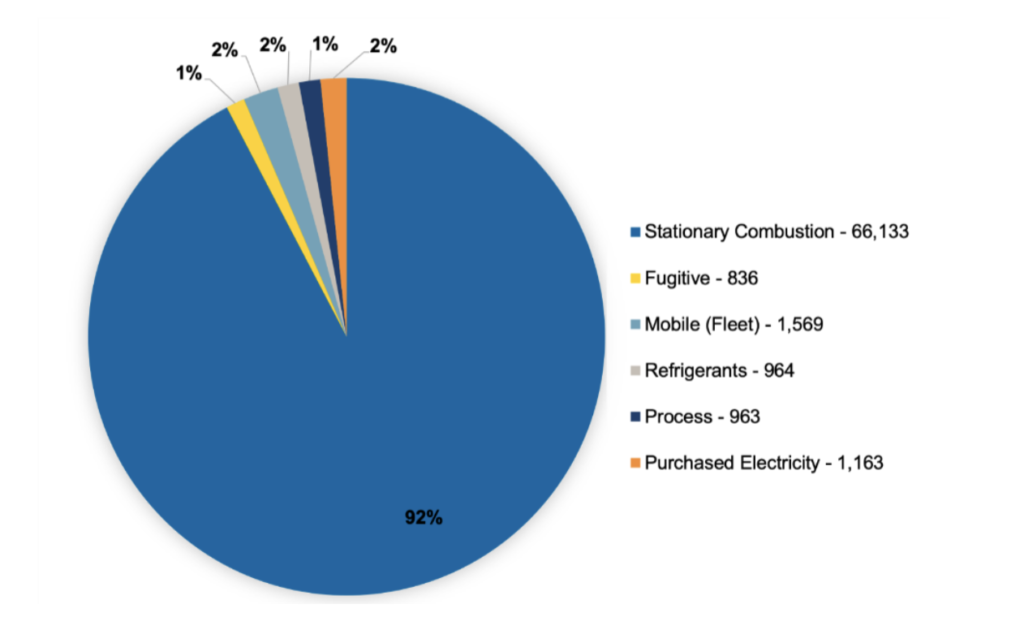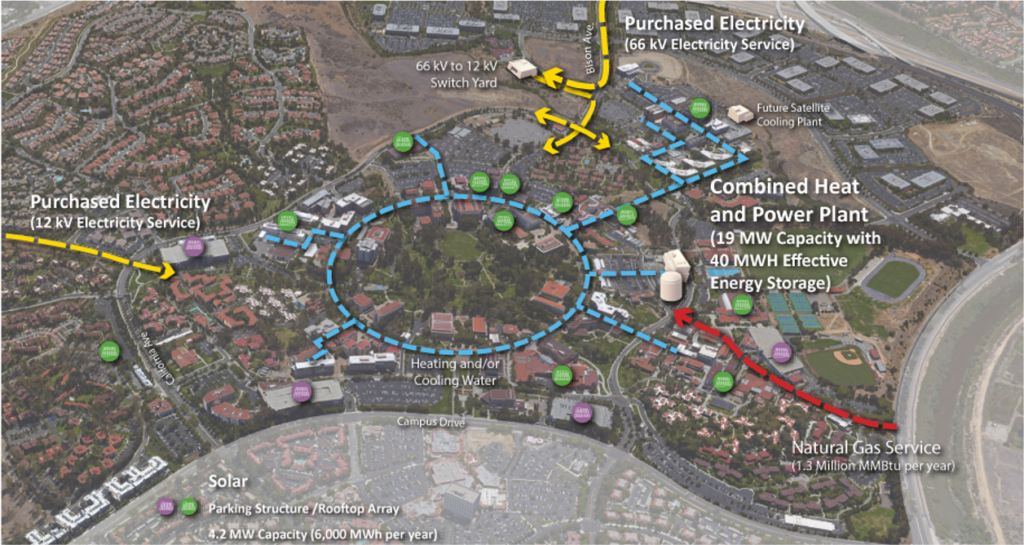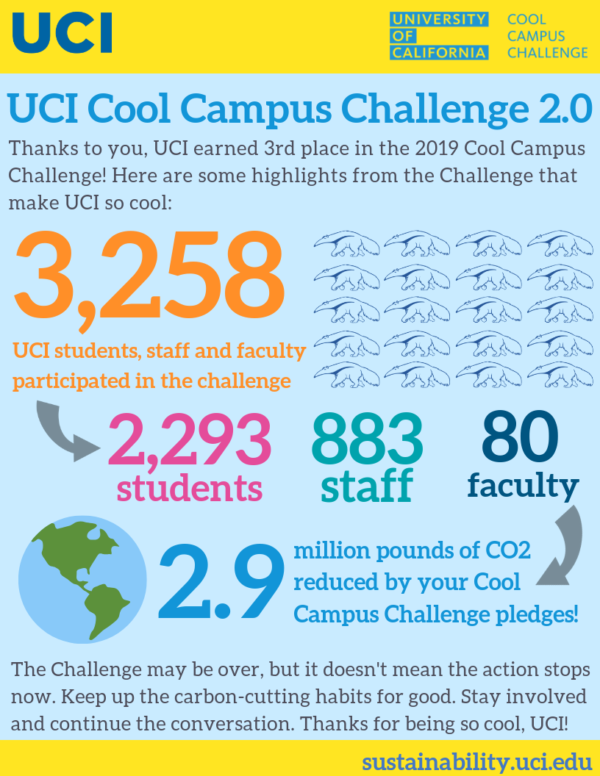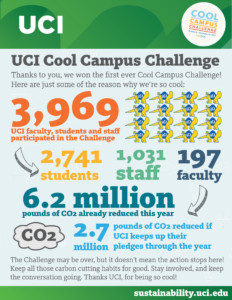Climate Protection and Energy
What is Climate Protection?
Climate protection targets the reduction of greenhouse gasses, and aims to prevent or reduce harm from pollution. Sustainability at UC Irvine heavily focuses on the reduction of greenhouse gasses emitted by the university, and achieving its goals of climate neutrality. Climate neutrality is reducing emissions as much as possible, then compensating for remaining emissions through strategies like carbon offsets in order to get to a next zero emission level.

The process of climate neutrality, reducing scope 1 and 2 emissions and balancing indirect offset reductions to meet net zero carbon emissions.
What is UCI’s Commitment to Climate Protection?
To further climate protection, the UCI campus has strengthened its longstanding commitment to sustainability by pledging to reduce greenhouse gas emissions. UCI has several institutional climate protection commitments, such as the University of California (UC) sustainability policy, the UC 2025 Carbon Neutrality Initiative, and campus sustainability goals. The UC system announced the Carbon Neutrality Initiative (CNI) and pledged to be carbon neutral by 2025 from scope 1 and 2 carbon emission sources, and the University of California’s comprehensive Sustainable Practices Policy, establishes goals in eight areas of sustainable practices: green building, clean energy, transportation, climate protection, sustainable operations, waste reduction and recycling, environmentally preferable purchasing, and sustainable foodservice.
UCI’s Climate Action Plan plan was adopted in 2007, and since been revised to pledge climate neutrality for Scope 1 and 2 sources by 2025, and climate neutrality including Scope 3 sources by 2050. The plan seeks to balance environmental and financial stewardship, focus on actions that support UCI’s mission and values, and engage all sectors of the UCI community in pursuit of UCI’s climate protection goals.
Climate
- Reduce greenhouse gas emissions to year 1990 levels by 2020.
- Achieve climate neutrality for scope 1 and 2 sources by 2025.
- Achieve climate neutrality from specific scope 3 sources (as defined by Second Nature’s Climate Commitment) by 2050 or sooner
Energy
- Energy efficiency: Reduce each location’s energy use intensity by an average of at least 2% annually.
- Clean electricity: By 2025, each campus and health location will obtain 100% clean electricity. By 2018, the University’s Clean Power Program will provide 100% clean electricity to participating locations.
- On-campus combustion: By 2025, at least 40% of the natural gas combusted on-site at each campus and health location will be biogas.
What is UCI’s Strategy to Reach Climate Neutrality?
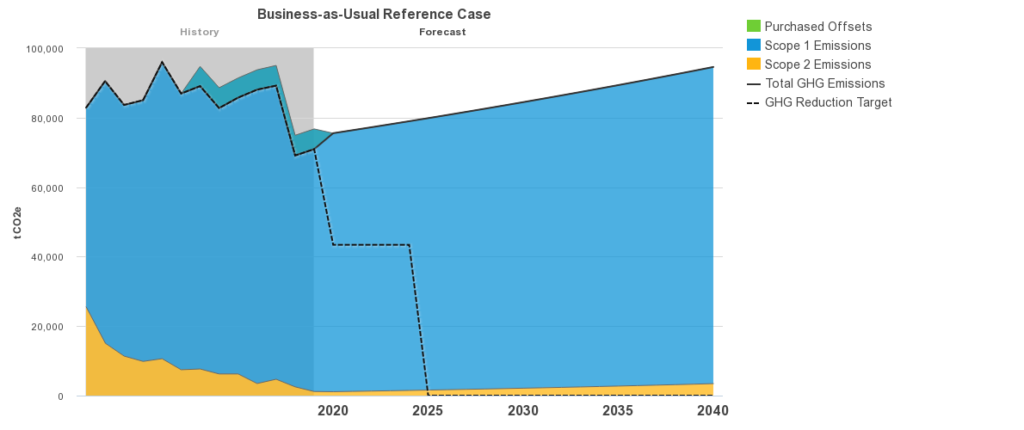
The business as usual carbon emissions for the UC system, separating scope 1, scope 2, and total emissions.
UCI will reach net zero greenhouse gas emissions through implementing sustainable practices, using the campus as a living laboratory for sustainability, and taking responsibility over the use of resources. The university’s Climate Action Plan uses a multi-tiered portfolio approach to carbon neutrality, focusing on planning low carbon growth, reducing energy demand, replacing energy systems with renewable ones, and mitigating emissions through carbon offsets.
What is UCI’s Reduction Plan?
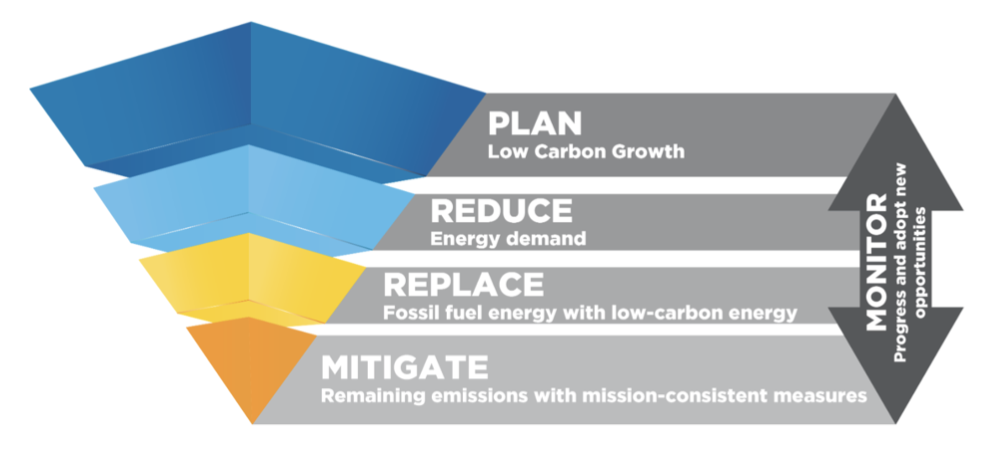
The UCI Climate Action Plan strategy laid out in a pyramid diagram.
Plan
Low Carbon Growth
To plan for low carbon growth in the future, UCI is implementing different strategies to advance building and energy systems. The Green Buildings program aims to construct planned facilities at LEED silver or gold levels, adding to its current 20 platinum and 10 gold USGBC LEED-certified buildings. The university will also optimize Co-gen and distributed generation by implementing microgrid projects for efficiency, energy storage, and integration of renewable energy.

The image depicts Plaza Verde, which is a new advanced housing complex on campus with a LEED Platinum rating.
Reduce
Energy Demand
To reduce energy demand, UC Irvine will implement deep energy efficiency programs and work on sustainable behavior. The campus fleet will be targeted for reducing energy consumption, in both stationary and mobile entities. The university will also target laboratories, using the Smart Labs and Green Labs programs. Smart labs is a deep energy efficiency program that targets energy use. Additionally, Green Labs is a certification program that promotes sustainable behavior and further promotes energy reduction.

The image depicts Energy Efficiency and Conservation Green Labs Program.
Replace
Low Carbon Energy
In order to reduce GHG emissions, the school will also aim to replace as many sources as possible with clean energy. UCI plans to improve upon its renewable energy infrastructure and invest in other methods of carbon-free energy like biomethane. To increase onsite solar renewable energy, UCI will implement second phase parking structure solar arrays. To further reduce greenhouse gas emissions, 10% of natural gas use will be replaced with biomethane beginning in 2025. For the transportation fleet, the campus will implement fuel switching for half of existing fleet operations and convert 20 diesel busses to EV.

The image depicts the UC Five Points Solar PAA.
Mitigate
Carbon Offsets
In order to achieve carbon neutrality by 2025 , UCI will procure carbon offsets to offset Scope 1 and 2 emissions. Carbon offsets are the ‘currency’ for offsetting in reductions of metric tons of carbon dioxide equivalents (MT CO2e). One carbon offset is equivalent to one MT CO2e. Offsets vary widely in price and typically come from five different project types: methane reduction, industrial gas reduction, energy efficiency, sequestration, or renewable energy. Procured offsets are a temporary solution and will align with UCI’s mission.

The image depicts an urban forestry carbon offsets project.
Interested in talking to your class about carbon offsets? Download this presentation from Brenna Biggs, the 2019-2020 CNI Carbon Offsets fellow.
Where is UCI on the Path to Climate Neutrality?

The portfolio of carbon emissions for the UC system, separating between the different strategic points such as green buildings and energy efficiency.

